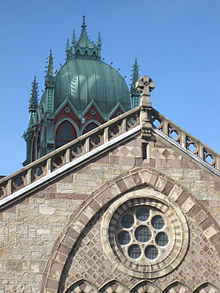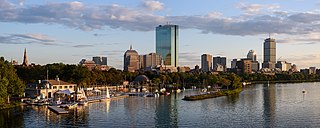
Back Bay is an officially recognized neighborhood of Boston, Massachusetts, built on reclaimed land in the Charles River basin. Construction began in 1859, as the demand for luxury housing exceeded the availability in the city at the time, and the area was fully built by around 1900. It is most famous for its rows of Victorian brownstone homes—considered one of the best preserved examples of 19th-century urban design in the United States—as well as numerous architecturally significant individual buildings, and cultural institutions such as the Boston Public Library, and Boston Architectural College. Initially conceived as a residential-only area, commercial buildings were permitted from around 1890, and Back Bay now features many office buildings, including the John Hancock Tower, Boston's tallest skyscraper. It is also considered a fashionable shopping destination and home to several major hotels.

Second Presbyterian Church is a landmark Gothic Revival church located on South Michigan Avenue in Chicago, Illinois, United States. In the late nineteenth and early twentieth centuries, some of Chicago's most prominent families attended this church. It is renowned for its interior, completely redone in the Arts and Crafts style after a disastrous fire in 1900. The sanctuary is one of America's best examples of an unaltered Arts and Crafts church interior, fully embodying that movement's principles of simplicity, hand craftsmanship, and unity of design. It also boasts nine imposing Tiffany windows. The church was listed on the National Register of Historic Places in 1974 and later designated a Chicago Landmark on September 28, 1977. It was designated a National Historic Landmark in March 2013.

Mariners' Church of Detroit is a church with worship services adhering to Anglican liturgical traditions located at 170 East Jefferson Avenue in Downtown Detroit, Michigan. It was founded in 1842 as a special mission to the maritime travelers of the Great Lakes and functioned as a parish of the Episcopal Diocese of Michigan until 1992, when the Michigan Court of Appeals ruled it was incorporated as an independent congregation. The church was listed on the National Register of Historic Places in 1971. The church has a non-exclusive, limited association with the REC Diocese of Mid-America which itself is a founding member of the Anglican Church in North America.

The Arlington Street Church is a Unitarian Universalist church across from the Public Garden in Boston, Massachusetts. Because of its geographic prominence and the notable ministers who have served the congregation, the church is considered to be among the most historically important in American Unitarianism and Unitarian Universalism. Completed in 1861, it was designed by Arthur Gilman and Gridley James Fox Bryant to resemble James Gibbs' St. Martin-in-the-Fields in London. The main sanctuary space has 16 large-scale stained-glass windows installed by Tiffany Studios from 1899 to 1930.

Christ Episcopal Church is a historic Episcopal church located at 43 South Broadway in Tarrytown, New York. Topped by a modest tower, the ivy-covered red brick church was built in 1837 and maintains an active congregation to the present day. The church also includes the San Marcos Mission, a Spanish-language ministry.

St. Michael's Church is a historic Episcopal church at 225 West 99th Street and Amsterdam Avenue on Manhattan's Upper West Side in New York City. The parish was founded on the present site in January 1807, at that time in the rural Bloomingdale District. The present limestone Romanesque building, the third on the site, was built in 1890–91 to designs by Robert W. Gibson and added to the National Register of Historic Places in 1996.

Charles Amos Cummings was a nineteenth-century American architect and architectural historian who worked primarily in the Venetian Gothic style. Cummings followed the precepts of British cultural theorist and architectural critic John Ruskin (1819–1900). Cummings help to found the Boston Society of Architects in 1867.

The Church of Saint-Merri or Église Saint-Merry) is a parish church in Paris, located near the Centre Pompidou along the rue Saint Martin, in the 4th arrondissement on the Rive Droite. It is dedicated to the 8th century abbot of Autun Abbey, Saint Mederic, who came to Paris on pilgrimage and later died there in the year 700. In 884 Mederic was declared patron saint of the Right Bank.

The Second Church in Newton, United Church of Christ, is located at 60 Highland Street in West Newton, a village of Newton, Massachusetts. This church is rooted in the Congregational denomination, welcomes all visitors, and does not require uniformity of belief. Its present church building, a Gothic Victorian structure designed by architects Allen & Collens and completed in 1916, was listed in the National Register of Historic Places in 1990.
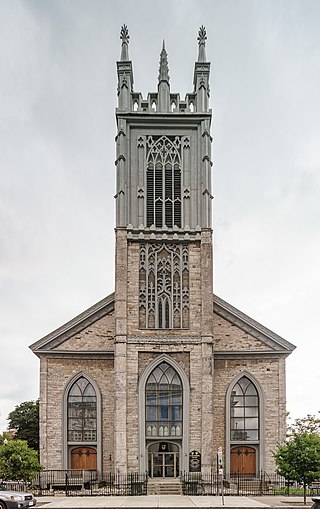
St. Paul's Episcopal Church in Troy, New York, United States, is located at Third and State streets. It is home to one of the oldest congregations in the city. In 1979, the church and two outbuildings were added to the National Register of Historic Places. Seven years later, when the Central Troy Historic District was created and added to the Register, it was listed as a contributing property.

St. John the Evangelist is a historic Roman Catholic Church at 2270 Massachusetts Avenue in Cambridge, Massachusetts.

Unitarian Memorial Church is a historic church on 102 Green Street in Fairhaven, Massachusetts, home to the Unitarian Universalist Society of Fairhaven.

The First Baptist Church of Tarrytown is located on South Broadway in Tarrytown, New York, United States. It is a stone building in the Victorian Gothic architectural style dating to the 1870s. In 1983 it and its rectory were listed on the National Register of Historic Places.

The First Presbyterian Church in Batavia, New York, United States, is located at East Main and Liberty streets. It is a joined complex of several buildings. The main one, the church's sanctuary, is a limestone Gothic Revival structure built in the mid-19th century. Its congregation was the first church to be organized in Batavia, albeit as a Congregationalist group at that time.

St. Thomas' Episcopal Church is located on Leedsville Road in Amenia Union, New York, United States. It is a mid-19th century brick church designed by Richard Upjohn in the Gothic Revival architectural style, built for a congregation organized shortly before.

St. Michael's Episcopal Church, Parish House and Rectory is a group of architecturally-significant religious buildings located at 200-216 North Mill Street in Birdsboro, Berks County, Pennsylvania. It was added to the U.S. National Register of Historic Places in 1982.

Gethsemane Lutheran Church is a historic Lutheran church in downtown Austin, Texas. Designated as a Recorded Texas Historic Landmark and listed on the National Register of Historic Places, the building currently holds offices of the Texas Historical Commission.

The First Presbyterian Church, known as "Old First", is a church located at 48 Fifth Avenue between West 11th and 12th Streets in the Greenwich Village neighborhood of Manhattan, New York City. It was built in 1844–1846, and designed by Joseph C. Wells in the Gothic Revival style. The south transept of the building was added in 1893–1894, and was designed by the firm of McKim, Mead & White. The church complex, which includes a parish house – now referred to as the "South Wing" – on West 11th Street and a church house on West 12th Street designed by Edgar Tafel, is located within the Greenwich Village Historic District.
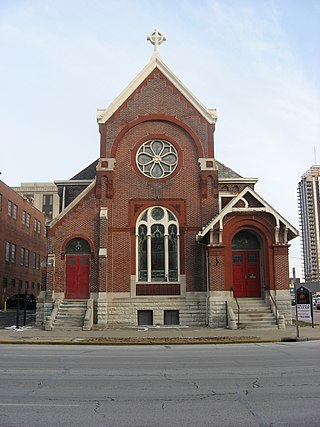
Mount Pisgah Lutheran Church, also known in its early years as the First Lutheran Church and First English Lutheran Church and more recently as The Sanctuary on Penn, is located at 701 North Pennsylvania Street in downtown Indianapolis, Indiana. The historic church was built by the city's first Lutheran congregation, which organized in 1837, and was its third house of worship. The former church, whose present-day name is The Sanctuary on Penn, is operated as a for-profit event venue.
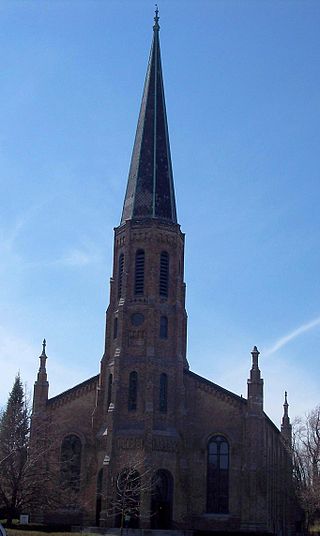
The Westminster Presbyterian Church is a historic Presbyterian church located in the Delaware Avenue neighborhood of Buffalo, Erie County, New York. The Romanesque Revival building completed in 1859 features a number of exception stained glass windows and is a contributing property to the Delaware Avenue Historic District designated in 1974.


